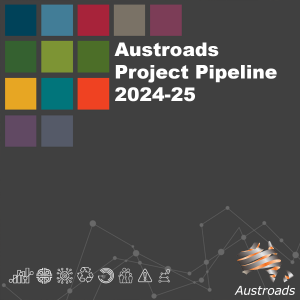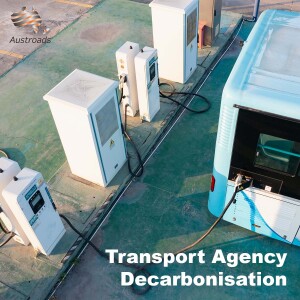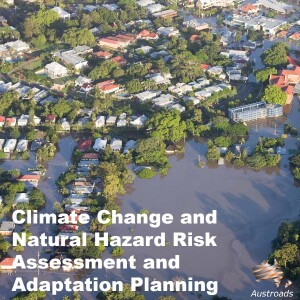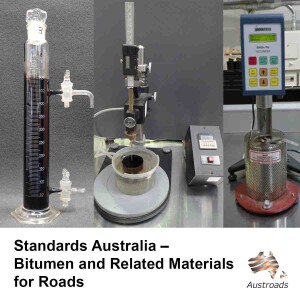Episodes

Thursday Dec 12, 2024
Austroads Project Pipeline 2024-25
Thursday Dec 12, 2024
Thursday Dec 12, 2024
Are you looking for an opportunity to work with Austroads to help Australian and New Zealand transport agencies deliver efficient, reliable, and safe mobility to their customers?
This webinar recording introduces new projects lined up for the 2024-25 financial year. Consultants interested in tendering for Austroads projects will find this session beneficial.
The session covers the Austroads tendering process with presentations from Austroads program managers:
- Ross Guppy, Program Manager Transport Infrastructure
- Michael Nieuwesteeg, Program Manager Road Safety and Design
- Amy Naulls, Program Manager Transport Network Operations
- Joanne Vanselow, Program Manager Future Vehicles and Technology, and Environment and Sustainability.
The webinar was moderated by Paul Davies, Austroads General Manager Programs.

Wednesday Dec 11, 2024
Austroads Guide to Digital Engineering
Wednesday Dec 11, 2024
Wednesday Dec 11, 2024
Following extensive engagement with industry, representative specialist groups and transport agency stakeholders across Australia and New Zealand, Austroads has developed a guide to digital engineering.
The purpose of the guide is to assist transport agencies in Australia and New Zealand to deliver and operate their assets more effectively through obtaining better value and consistency in the application of digital engineering capability.
The guide communicates the need for a strategic approach to digital engineering alongside careful consideration and planning, clear engagement and support for its implementation.
This webinar, presented by Will Hackney and David Heins, provides an overview of the guide, including why it is needed, the structure of the guide, approaches to developing a strategy, roadmap, implementation planning, learning and development framework, and case studies.

Thursday Dec 05, 2024
Passenger Cars and other Non-Truck Crumb Rubber in Asphalt: Demonstration Project
Thursday Dec 05, 2024
Thursday Dec 05, 2024
The project aimed to assess and demonstrate the viability of incorporating other-than-truck tyres crumb rubber into asphalt applications from an operational and constructability standpoint. Following the initial part of the project that assessed the readiness of the tyre recycling and asphalt industries to handle crumb rubber from any sources of end-of-life tyres, the demonstration project in Tasmania showed no significant differences among the three asphalt mixes, suggesting that more attention should be directed towards crumb rubber produced from tyres other than trucks – some of which are only minimally recycled despite their significant volume.
This webinar, presented by Tony Aloisio from the Australian Flexible Pavement Association, will provide a detailed overview of the demonstration project in Tasmania and its findings.

Wednesday Dec 04, 2024
Transport Agency Emissions Reduction Opportunities
Wednesday Dec 04, 2024
Wednesday Dec 04, 2024
Transport sector emissions are a significant and growing contributor to both Australia and New Zealand’s total greenhouse gas emissions. Enabled transport sector emissions – those occurring as a result of use of transport systems (e.g. road user emissions) account for the largest portion of transport sector emissions. Beyond road user emissions, there are also significant emissions associated with direct transport agency operations and supply chain embodied emissions from the construction and maintenance of associated infrastructure.
The Decarbonisation Decision-Making Guidance (User Guide), and associated multi-criteria analysis (MCA) tool, aims to assist agencies and practitioners in the strategic prioritisation of emission reduction interventions. The User Guide and MCA tool are designed to work alongside (not replace) established decision-making processes such as business cases and cost-benefit analysis. The User Guide and MCA tool provide a systematic approach for assessing and prioritising interventions and facilitating an evidence-based decision-making process to prioritise the most impactful, cost-effective, and technologically viable options. The approach was developed in line with the Infrastructure Australia Guide to multi-criteria analysis – Technical guide of the Assessment Framework.
This webinar, presented by Nick Gallaugher and Georgia Harmey, provides an overview of the User Guide and MCA tool outlining the key concepts and process.

Wednesday Dec 04, 2024
Climate Change and natural Hazards Risk Assessment and Adaptation Planning
Wednesday Dec 04, 2024
Wednesday Dec 04, 2024
Transport infrastructure and systems are typically designed to withstand local weather events based on historical records of climate. However, historical climate data is no longer a reliable predictor of future impacts due to climate change. Extreme weather events are projected to become more frequent and intense, increasing the vulnerability of transport networks and the communities they serve.
Austroads has developed Climate Change and Natural Hazard Risk Assessment and Adaptation Planning Guidelines. The guidelines set out a framework for transport agencies to consider when undertaking climate change and natural hazard risk assessments and developing adaptation plans with examples provided throughout. The guidelines are intended to be flexible, guiding the application of both high-level and detailed risk assessments of physical and transition risks.
This webinar, presented by Allan Klindworth and Upeshika Heenetigala, will step through the process set out in the guidelines, highlighting key concepts with examples and supporting resources. There will be question and answer opportunities during the session.

Friday Nov 29, 2024
Friday Nov 29, 2024
Christchurch has developed over 75km of separated cycle facilities retrofitted across the road network. The Major Cycleway Programme has enabled Christchurch to become the leader for cycle infrastructure in New Zealand. The 2011 earthquakes experienced in Canterbury, New Zealand caused significant devastation and destruction across the city. This disaster was a catalyst for change and provided Christchurch an opportunity to rebuild new and create a new identity.
This webinar, presented by Emily Cambridge from Activate Urban and Jacob Bradbury from Christchurch City Council, takes you on the Christchurch journey towards becoming a cycle friendly city. This includes discussing The Share an Idea campaign which empowered the Christchurch community to share their dreams for the future of the city. The campaign attracted more than 100,000 ideas. The Major Cycleway network emerged as part of the city rebuild blueprint. This programme planned a network with over 100km of separated cycleways along 13 major routes across the city. In 2016, two consultant led consortia were established to complete the route designs. Now with 11 of the 13 routes nearing completion there has been exponential growth of people riding bikes over the past 5 years.
One of the completed routes has seen an average 30% growth in cyclists between 2019 and 2020. Recent surveys with users and residents also show strong support for the facility with 82% of cycle users surveyed stated that the new cycleway has encouraged them to make more trips by bike.
The webinar shares how the design team has progressed through route planning, design team consortia collaboration, construction and will touch on some lessons learnt along the journey.

Thursday Oct 31, 2024
Addressing Head-on Conflicts Towards a Safe System Alignment
Thursday Oct 31, 2024
Thursday Oct 31, 2024
Head-on crashes are a serious issue in Australia and New Zealand. Head-on crashes result in significantly higher trauma than most other crash types. The provision of an appropriate median or centreline treatment is important to mitigate the risk of head-on crashes.
In this webinar, Dr Rod Troutbeck, Jade Hogan and Jamie Robertson described the range of improvements from supportive treatments like pavement markings and audio-tactile line markings through to the use of flexible barriers in narrow medians as a primary treatment. The discussion and guidance centre on rural two-lane roads but also applicable to all roads. The recommended practices are based on both literature and case studies.
The presenters introduced the crash modification factors developed for the hierarchy of approaches to address head-on crashes and the case studies that support these factors. The optimum solution is to provide a median barrier, however other treatments may be appropriate in certain circumstances depending on considerations including road function, space or resource constraints, and access requirements. The designer should start with the option that has the greatest Safe System alignment. It will need to be demonstrated that this option is not feasible before investigating and selecting an option with lower Safe System alignment are prioritised and other alternatives must be given lower emphasis.
The presenters discussed the implications for road designers including the treatment’s applicability, effectiveness and dimensions. The maintenance considerations and implications for other road users, including sight distance requirements were also discussed.

Monday Oct 28, 2024
National Harmonisation of Road Safety Audit Practices
Monday Oct 28, 2024
Monday Oct 28, 2024
By applying road safety knowledge to road projects throughout their lifecycle, road safety audits provide greater confidence to road authorities that potential and actual road safety risks are identified and can be mitigated.
Road safety auditors are currently managed individually by state and territory road agencies, leading to variability in training, accreditation, registration, and continuing professional development requirements across Australia and New Zealand.
Austroads members are committed to improving the consistency and quality of road safety audit practices across Australia and New Zealand and have agreed to implement a national framework to manage road safety auditors and road safety audit training providers.
This webinar provided an overview of the national harmonisation project, including why it is needed, the anticipated benefits, what the national framework will look like, as well as project deliverables and timelines.
The webinar was presented by Michael Nieuwesteeg, Chris Koniditsiotis, Andrew Lee and Kellie Houlahan.
There were question and answer opportunities during the session.

Thursday Aug 22, 2024
Driver Distraction Roadmap: Implementation Guide
Thursday Aug 22, 2024
Thursday Aug 22, 2024
The implementation of the National Roadmap on Driver Distraction is a commitment under Australia’s National Road Safety Strategy 2021-2030. Austroads has released a guide for this work and is preparing two research and development projects for delivery over the next financial year.
The webinar presents the guide, the first projects being prepared, and encourage further discussion and ongoing engagement about this important road safety issue.
This webinar is presented by Matin Nabavi, Mike Regan and Martin Small.

Tuesday Aug 20, 2024
Standards Australia – Bitumen and Related Materials for Roads (2022-24)
Tuesday Aug 20, 2024
Tuesday Aug 20, 2024
The webinar provides an overview of an Austroads project which provided expert technical input into the revision of three Australian Standard test methods (AS 2341.4, AS 2341.15 and AS 2341.27) and three national specification documents (AS 2008, AS 2157, AS 1160) during the period between September 2022 and August 2024. It also includes the results of a laboratory study which investigated whether consistency at 25 °C tests (AS 2341.25) could be replaced by rotational viscosity at 25 °C tests (AS 2341.4) in the bituminous emulsion specification (AS 1160).

